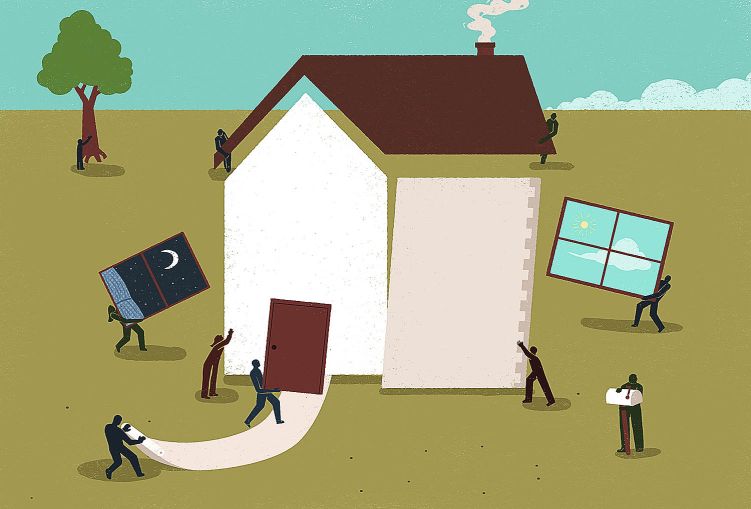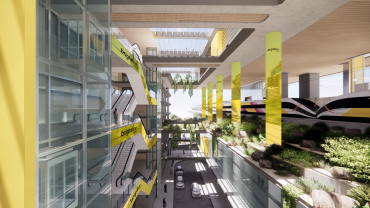NYC Slowly Builds a New Generation of Limited-Income Co-Ops
By Rebecca Baird-Remba April 18, 2023 8:00 am
reprints
New York City has financed tens of thousands of rental units over the last decade, but one little-known city program that builds affordable co-ops and townhomes is starting to get off the ground, too. Hundreds of units, in fact, are either planned or underway despite financing challenges and an ongoing debate about how much equity buyers should be able to build.
Since the program, Open Door, was launched in 2018, it has successfully financed six developments across the five boroughs. Buyers usually put down 5 percent of the purchase price — compared to at least 20 percent in a typical co-op apartment deal — and are often low- to moderate-income. But only one building has been finished so far. Open Door’s very first project, Sydney House, brought 56 income-limited co-ops to the Williamsbridge section of the northern Bronx two years ago.
Asking prices at Sydney House ranged from $188,823 for a small one-bedroom and went up to $326,000 for a three-bedroom. Habitat for Humanity, which was involved in creating the city’s first income-limited co-ops under the Housing Development Fund Corporation in the 1970s, co-developed the project with Almat Group. Buyers could put down as little as 1 percent of the purchase price and had access to 2 percent fixed-rate mortgages from the State of New York Mortgage Agency.
Purchasers were also required to participate in Habitat’s sweat equity program by volunteering on home construction projects or helping the nonprofit with administrative work, and were also expected to take homebuyer education courses. Income levels ranged from as little as $38,000 for a single person buying a one-bedroom to as much as $111,240 for a family of six buying a three-bedroom.
These new apartments are legally structured as Housing Development Fund Corporation co-ops, otherwise known as HDFCs, but they have different regulations than their 1970s and 1980s cousins. Under the current rules, the new co-ops can accrue only 2 percent of their purchase price in value annually for 40 years after they are built. Of course, buyers must use the apartment as their primary home.
Open Door is a departure from the last 30 years of city-subsidized home ownership, which mostly focused on income-restricted condos. The condo financing rules effectively forced buyers to hold on to the unit for 15 years, unless they wanted to pay back some percentage of the purchase price. After 15 years, the apartment would be free of mortgage restrictions and could be sold for any price.
“After 15 years, all the subsidy value evaporates, so that unit essentially becomes market rate,” said Matthew Dunbar, the chief strategy officer at Habitat for Humanity. “That model was a good model in terms of bringing units back online, but the investment that was put into making those units didn’t apply to later generations of homebuyers. If you structure a limited equity co-op as an HDFC, they can access Article 11 tax abatements. And limited-equity cooperatives have restrictions on future buyers. If the city is investing more subsidy into creating more units, there should be additional public benefit.”
Dunbar added that the new co-ops “are homeownership but they’re not purely investment. It balances community needs, family needs, and it’s a better use of public dollars.”
Now major affordable housing developers are planning to build income-limited co-ops and, in some cases, are working with community land trusts to do so. Camber Property Group, for example, is working on two affordable co-op projects in the Bronx, including one with Interboro Community Land Trust. That development, Claremont Green, will rise on vacant, city-owned land at 1640 Anthony Avenue in the Claremont section of the west Bronx. Camber, Habitat for Humanity and Almat are developing the eight-story, 63-unit project, which will be owned by Interboro after construction.
Another project involves the redevelopment of Stevenson Commons, a sprawling midcentury, tower-in-the-park Mitchell-Lama complex in the Soundview section of the southeast Bronx. Camber already renovated the existing 1,000 apartments and kept them affordable through a new 30-year Section 8 contract with the city and federal government. The first phase of the development, which will rise on vacant land next to the existing towers, will include 50 affordable co-ops in three- and four-story buildings. All told, Camber plans to add 940 new apartments, including low-income senior housing and regular affordable rentals.
Camber CEO Rick Gropper noted that Open Door is challenging to use because it requires significant government subsidy, cheap land and the right kind of property.
“You need the right site to use the Open Door program, where you have a low land basis,” Gropper noted. “I don’t think it’s ideal for a site that’s 200 units. But if you have something that’s on the smaller side, it’s a program that’s important and is in high demand across the entire city.”
The city’s Department of Housing Preservation and Development (HPD) has not yet finalized financing for either of Gropper’s Open Door projects, and rising interest rates only make these apartments more expensive for the city to finance. The developer said he began working on Stevenson Commons when he acquired it in 2017, and hoped to close financing for the co-op portion later this year.
“The way these things get subsidized is city subsidy and purchase price,” said Gropper. “The higher interest rate requires more subsidy to make the apartments more affordable. I think it’s more sensitive to interest rates than traditional rental housing.”
Dunbar, the Habitat for Humanity executive, noted that the nonprofit had a backlog of unbuilt affordable co-op projects on city-owned land stretching back roughly a decade. He argued that the city could have financed them for significantly less before the pandemic.
“The cost of delay is real,” he said. “If we had closed some of these projects three years ago, they would have been a lot less costly. The result is always that it costs more.”
L+M Development Partners also hopes to add a co-op portion to Bronx Point, an affordable development that’s otherwise rental under construction next to the 145th Street Bridge in the South Bronx. The second phase of the project could add as many as 400 new units to the 542 in the first phase.
Spencer Orkus, the president of development at L+M, worried that the 2 percent annual increase in value might be too low for many New Yorkers hoping to build wealth through home equity.
“We want to create a situation where people can allow their apartment to appreciate and build wealth while also keeping these apartments available to the middle class,” said Orkus. “Two percent is just too low. If the value of people’s apartments doesn’t increase, they’re going to be reluctant to keep it in good condition. It’s hard to be able to put money into an apartment if you’re not able to sell the unit for a higher price to recoup the investment. It will discourage proper upkeep of buildings. We gotta let the pendulum find the middle now. The current program was a reaction against previous programs where perhaps people made too much money off the affordable homeownership programs.”
HPD, for its part, said that the 2 percent cap wasn’t set in stone. It may raise the cap in the future, though housing officials couldn’t provide specifics. The agency noted that the program was geared more toward keeping apartments affordable rather than building equity.
“My parents achieved the American dream [by] buying their first home in the Bronx, which would not have been possible without the government support that existed then,” HPD Commissioner Adolfo Carrión Jr. said in a statement. “Now we have the opportunity to make that dream a reality for a new generation of New Yorkers through programs like Open Door. This administration is committed to delivering more affordable opportunities for New Yorkers to become homeowners and generate wealth for their families — opening new doors with the city’s support.”
Habitat for Humanity is also involved in a handful of new construction townhouse projects financed by Open Door. The group is trying to develop several small, city-owned lots scattered across Brooklyn’s Bedford-Stuyvesant, Brownsville and East New York into three- and four-story buildings.
“Smaller sites that are more challenging end up being taken on by nonprofit organizations like ours,” Dunbar said. “Oftentimes the hardest-to-develop sites were the ones selected to be built as homeownership, which is why there’s been so little homeownership created. You’re talking about four-story walk-ups rather than a large elevator building. You’re doing 14 buildings but only getting four units out of each one. So it becomes much more challenging to finance and close on these projects.”
He noted that part of the challenge involved replicating architectural plans and building permits more than a dozen times, and managing so many separate construction sites. These lots, he said, were awarded to Habitat under the rules that predate Open Door’s 2018 launch.
The nonprofit is also working on small Passive House townhomes in South Jamaica, Queens. The New York City Housing Authority previously owned 13 dilapidated homes in the neighborhood, 10 of which will be demolished to make way for new, modular homes. Another three will be gut renovated. All of the homes will be built to Passive House standards, with rooftop solar panels and heat pumps. Interboro Community Land Trust will own the land and ground-lease it to the future homeowners.
“It’s really exciting that the city has acknowledged the community land trust model where the nonprofit owns the land and the cooperators own the improvements,” said Dunbar. “That’s not allowed with condos. Condos cannot go on CLTs.”
Ultimately, he felt that co-ops would always be harder to finance than other kinds of housing because they cannot really benefit from Low Income Housing Tax Credits, a federally backed program that facilitates the financing of affordable rentals.
“I’m really glad to see HPD moving towards emphasizing homeownership more,” Dunbar said. “When you end up prioritizing unit count, you end up prioritizing the easier-to-finance projects, which are usually rentals.”


